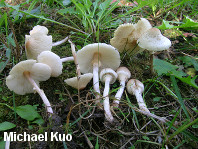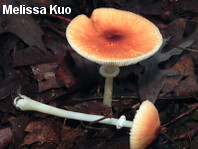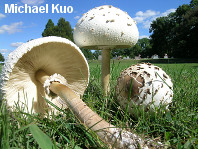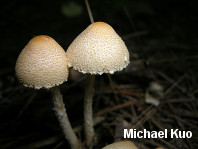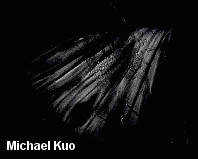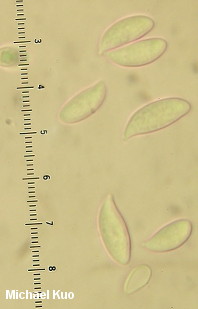| Major Groups > Gilled Mushrooms > Pale-Spored > Lepiotoid Mushrooms |

|
Lepiotoid Mushrooms [ Basidiomycota > Agaricales > Agaricaceae . . . ] by Michael Kuo The "lepiotoid mushrooms" include species featuring white spore prints, gills that are free from the stem, partial veils that often leave a ring on the stem—and, under the microscope, spores that are smooth, and usually dextrinoid. They can be very similar to species of Amanita; however, most (though not all) lepiotoid mushrooms are smaller than most amanitas and lack volvas. Additionally, most amanitas are mycorrhizal, while most lepiotoid mushrooms are saprobic—which means they "act" differently; amanitas are associated with trees (with a very few saprobic exceptions), while lepiotoid mushrooms are associated with litter. Most lepiotoid mushrooms were once contained in the genus Lepiota and, depending on the age of your field guide, your books may still use this genus name in the wide sense. But today's Lepiota is not your grandmother's Lepiota. Microscopic analysis and, more recently, DNA studies, have wreaked havoc on the former genus, leaving us with a smaller, core group of mushrooms (like Lepiota cristata) that are "really" species of Lepiota—and a host of other genus names (Cystolepiota, Macrolepiota, Leucoagaricus, Leucocoprinus, Chlorophyllum . . .) for the rest. In fact, seemingly diverse mushrooms like the brown-spored Agaricus campestris and the black-spored, gill-digesting Coprinus comatus have been shown to be closely related to the lepiotoid mushrooms, indicating that spore print color can be an inadequate indicator of genetic relationships. With a few exceptions, identifying lepiotoid mushrooms is usually a challenge. Aside from the larger, charismatic "field guide species," there are untold dozens of North American species that may, or may not, correspond to the better-documented European lepiotoid flora. Identification features that can be assessed without a microscope include colors, an assessment of the texture of the cap surface, bruising and staining reactions, the odor of the crushed flesh, and a close look at the morphology of the stem and the disposition of veil remnants. For this reason the stems of lepiotoid mushrooms should not be handled during the collecting process; ephemeral rings and sheathing shagginess can be easily rubbed away. Most lepiotoid identifications, however, will require microscopic analysis. I have found that both a cross-sectional Roman aqueduct section and a radial cap section that includes the center of the cap are usually required, both mounted in KOH—along with a third slide of mature gill tissue (or a spore print scraping) mounted in Melzer's reagent. In other words, studying lepiotoid mushrooms under the microscope means a bunch of work. Microscopic features to observe include the structure of the pileipellis, the morphology of the (often boring and hard-to-distinguish) cheilocystidia, and the morphology of the spores. The pileipellis (which Else Vellinga, the most prolific contemporary lepiotoid author, calls the "pileus covering") must be assessed over the center of the cap, where the pigment has not broken up into scales or patches. As for the spore morphology . . . be prepared for a much more finely honed assessment of spore shapes than is often required in the non-lepiotoid world. As for advanced lepiotoid literature . . . well, good luck. The references list below contains some very outdated North American treatises, along with a veritable host of publications by Vellinga, several of which are fantastic for California, but none of which is comprehensive for North America. I usually start my lepiotoid identification attempts with the question, "What would this be called if we were in Europe?" . . . and attempt to use keys in Vellinga 2001c-2001h. Next, I attempt to key my lepiotoids in Smith (1954) and in Kauffman (1924) and, if I have still had no luck, I ask myself whether I have the patience to prowl through the long list of lepiotoid studies that treat one or a few North American species. I usually don't. |
|
|
Lepiotoid species pages Chlorophyllum brunneum References Akers, B. P. & W. J. Sundberg (1998). Lepiotaceae of Florida, I. Lepiota s. str., section Ovisporae. Mycotaxon 69: 429–436. Akers, B. P. & W. J. Sundberg (1999). Lepiotaceae of Florida, II. Lepiota s. str., section Fuscovinacae. Mycotaxon 70: 453–460. Akers, B. P. & W. J. Sundberg (2000). Lepiotaceae of Florida, III. Lepiota s. str., section Lepiota. Mycotaxon 75: 137–145. Akers, B. P., S. A. Angels & J. W. Kimbrough (2000). Leucoagaricus viridiflavoides, a new species from Florida, with notes on related taxa. Mycotaxon 76: 39–50. Akers, B. P. & W. J. Sundberg (2001). Lepiotaceae of Florida, IV. Stenosporic species of Lepiota s. str.. Mycotaxon 80: 469–479. Birkebak, J. M., E. C. Vellinga, A. E. Franco-Molano, M. G. Wood & P. Brandon Matheny (2011). Lepiota maculans, an unusual mushroom rediscovered after 105 years. Southeastern Naturalist 10: 267–274. Bon, M. (1981). Cle monographique des “lepiotes” d’Europe. Documents Mycologiques 11: 1–78. Burlingham, G. S. (1945). Noteworthy species of Lepiota and Lactaria. Mycologia 37: 53–64. Ge, Z. W., Z. L. Yang & E. C. Vellinga (2010). The genus Macrolepiota (Agaricaceae, Basidiomycota) in China. Fungal Diversity 45: 81–98. Johnson, J. & Vilgalys, R. (1998). Phylogenic systematics of Lepiota sensu lato based on nuclear large subunit rDNA evidence. Mycologia 90: 971–979. Johnson, J. (1999). Phylogenetic relationships within Lepiota sensu lato based on morphological and molecular data. Mycologia 91: 443–458. Kauffman, C. H. (1924). The genus Lepiota in the United States. Papers of the Michigan Academy of Science, Arts, and Letters 4: 311–344. Kyde, M. M. & J. L. Peterson (1986). A variant of Lepiota cristata. Mycologia 78: 851–853. Lange, C. (2008). Chlorophyllum. In Knudsen, H. & J. Vesterholt, eds. Funga Nordica: Agaricoid, boletoid and cyphelloid genera. Copenhagen: Nordsvamp. 531–532. Lange, C. (2018). Lepiota. In Knudsen, H. & J. Vesterholt, eds. Funga Nordica: Agaricoid, boletoid, clavarioid, cyphelloid and gastroid genera. Copenhagen: Nordsvamp. 627–637. Liang, J. F., Z. L. Yang, J. Xu & Z. W. Ge (2010). Two new unusual Leucoagaricus species (Agaricaceae) from tropical China with blue-green staining reactions. Mycologia 102: 1141–1152. Montoya, L. & V. M. Bandala (2005). A new species and a new record of Lepiota occurring in the Gulf of Mexico area. Mycotaxon 94: 111–125. Moreno, G., A. Banares & M. Heykoop (1995). Macrolepiota molybdites (Meyer: Fr.) comb. nov., new to the Canary Islands. Mycotaxon 55: 467–471. Morgan, A. P. (1906, 1907). North American species of Lepiota. The Journal of Mycology 12: 154–159, 195–203, 242–248; 13: 1–18. Reid, D. A. (1989). Notes on some Leucocoprinoid fungi from Britain. Mycological Research 93: 413–423. Smith, A. H. & P. M. Rea (1944). Fungi of southern California: II. Mycologia 36: 125–137. Smith, H. V. (1954). A revision of the Michigan species of Lepiota. Lloydia 17: 307–328. Smith, H. V. (1966). Contributions toward a monograph on the genus Lepiota, I. Type studies in the genus Lepiota. Mycopathologia et Mycologia Applicata 29: 97–117. Smith, H. V. & Sundberg, W. J. (1979). Studies on the Lepiotaceae of the Pacific Coast region. I. Two new species. Mycotaxon 8: 446–452. Smith, H. V. (1981). Some species of Leucocoprinus which grow in greenhouses. Michigan Botanist 20: 45–52. Smith, H. V. & N. S. Weber. (1982). Selected species of Leucocoprinus from the southeastern United States. Contributions to the University of Michigan Herbarium 15: 297–309. Smith, H. V. & N. S. Weber (1987). Observations on Lepiota americana and some related species. Contributions from the University of Michigan Herbarium 16: 211–221. Sundberg, W. J. (1967). The family Lepiotaceae in California. Master's Thesis, San Francisco State Univ. 219 p. Sundberg, W. J. (1971a). A new species of Lepiota. Mycologia 63: 79–82. Sundberg, W. J. (1971b). The genus Chlorophyllum (Lepiotaceae) in California. Madrono 21: 15–20. Sundberg, W. J. (1976). Lepiota sensu lato in California. II. Type studies of Lepiota cupressa and Lepiota marginata. Mycotaxon 3: 381–386. Vellinga, E. C. & H. A. Huijser (1997). Lepiota xanthophylla and its greenhouse counterpart. Bollettino del Gruppo Micologico G. Bresadola 40: 457–464. Vellinga, E. C. & H. A. Huijser (1998). Studies in Lepiota. I. Species with a hymeniform pileus covering. Belgian Journal of Botany 131: 191–210. Vellinga, E. C., A. E. Franco-Molano & C. Bas (1998). Studies in Lepiota II. - Lepiota rubella. Sydowia 50: 272–277. Vellinga, E. C. (2000). Notes on Lepiota and Leucoagaricus. Type studies on Lepiota magnispora, Lepiota barsii, and Agaricus americanus. Mycotaxon 76: 429–438. Vellinga, E. C. (2001a). Studies in Lepiota III. Some species from California, U.S.A. Mycotaxon 80: 285–295. Vellinga, E. C. (2001b). Studies in Lepiota IV. Lepiota cristata and L. castaneidisca. Mycotaxon 80: 297–306. Vellinga, E. C. (2001c). Chlorophyllum. In Noordeloos, M. E., Th. W. Kuyper & E. C. Vellinga. Flora Agaricina Neerlandica: Critical monographs on families of agarics and boleti occurring in the Netherlands. Volume 5. Lisse: A. A. Balkema. 74–75. Vellinga, E. C. (2001d). Leucoagaricus. In Noordeloos, M. E., Th. W. Kuyper & E. C. Vellinga. Flora Agaricina Neerlandica: Critical monographs on families of agarics and boleti occurring in the Netherlands. Volume 5. Lisse: A. A. Balkema. 85–108. Vellinga, E. C. (2001e). Leucocoprinus. In Noordeloos, M. E., Th. W. Kuyper & E. C. Vellinga. Flora Agaricina Neerlandica: Critical monographs on families of agarics and boleti occurring in the Netherlands. Volume 5. Lisse: A. A. Balkema. 76–84. Vellinga, E. C. (2001f). Macrolepiota. In Noordeloos, M. E., Th. W. Kuyper & E. C. Vellinga. Flora Agaricina Neerlandica: Critical monographs on families of agarics and boleti occurring in the Netherlands. Volume 5. Lisse: A. A. Balkema. 64–73. Vellinga, E. C. (2001g). Cystolepiota. In Noordeloos, M. E., Th. W. Kuyper & E. C. Vellinga. Flora Agaricina Neerlandica: Critical monographs on families of agarics and boleti occurring in the Netherlands. Volume 5. Lisse: A. A. Balkema. 154–160. Vellinga, E. C. (2001h). Lepiota. In Noordeloos, M. E., Th. W. Kuyper & E. C. Vellinga. Flora Agaricina Neerlandica: Critical monographs on families of agarics and boleti occurring in the Netherlands. Volume 5. Lisse: A. A. Balkema. 109–151. Vellinga, E. C. (2002). New combinations in Chlorophyllum. Mycotaxon 83: 415–417. Vellinga, E. C. (2003a). Type studies in Agaricaceae - Chlorophyllum rachodes and allies. Mycotaxon 85: 259–270. Vellnga, E. C. (2003b). Phylogeny of Lepiota (Agaricaceae)- Evidence from nrITS and nrLSU sequences. Mycological Progress 2: 305–322. Vellinga, E. C. (2003c). Chlorophyllum and Macrolepiota (Agaricaceae) in Australia. Australian Systematic Botany 16: 361–370. Vellinga, E. C., R. P. J. de Kok & T. D. Bruns (2003). Phylogeny and taxonomy of Macrolepiota (Agaricaceae). Mycologia 95: 442–456. Vellinga, E. C. (2004). Genera in the family Agaricaceae: evidence from nrITS and nrLSU sequences. Mycological Research 108: 354–377. Vellinga, E. C. (2004b). Ecology and distribution of Lepiotaceous fungi (Agaricaceae). A review. Nova Hedwigia 78: 273–299. Vellinga, E. C. (2006a). Chlorophyllum in Great Britain. Field Mycology 7: 136–140. Vellinga, E. C. (2006b). Lepiotaceous fungi in California, U. S. A. —2. Lepiota rhodophylla sp. nov. Mycotaxon 98: 205–211. Vellinga, E. C. (2006c). Lepiotaceous fungi in California, U. S. A. —3. Pink and lilac species in Leucoagaricus sect. Piloselli. Mycotaxon 98: 213–224. Vellinga, E. C. (2006d). Lepiotaceous fungi in California, U. S. A. —4. Type studies of Lepiota fumosifolia and L. petasiformis. Mycotaxon 98: 225–232. Vellinga, E. C. & R. M. Davis (2006). Lepiotaceous fungi in California, U. S. A. —1. Lepiota amanitoides sp. nov. Mycotaxon 98: 197–204. Vellinga, E. C. (2007a). Key to the Cystolepiota species in western North America. Published by the author. Vellinga, E. C. (2007b). Lepiotaceous fungi in California, U. S. A. —5. Lepiota oculata and its look-alikes. Mycotaxon 102: 267–280. Vellinga, E. C. (2007c). What ever happened to the shaggy parasol? McIlvainea 16: 11–17. Vellinga, E. C. (2008a). Bibliography of North American Lepiota species. Version 2.1. Published by the author. Vellinga, E. C. (2008b). Chlorophyllum. Published by the author. Vellinga, E. C. & W. J. Sundberg (2008). Lepiotaceous fungi in California, U. S. A. 6. Lepiota castanescens. Mycotaxon 103: 97–108. Vellinga, E. C. (2009). Nomenclatural overview of Lepiotaceous fungi. Version 4.7. Published by the author. Vellinga, E. C. (2010a). Lepiota in California: species with a hymeniform pileus covering. Mycologia 102: 664–674. Vellinga, E. C. (2010b). Lepiotaceous fungi in California, U. S. A.: Leucoagaricus sect. Piloselli. Mycotaxon 112: 393–444. Vellinga, E. C., M. Contu & A. Vizzini (2010). Leucoagaricus decipiens and La. erythrophaeus, a new species pair in sect. Piloselli. Mycologia 102: 447–454. Vellinga, E. C. & S. R. Pennycook (2010). Making a case for the original spelling of an epithet: 'Correction' of the original spelling of Agaricus rachodes to Agaricus rhacodes (Basidiomycota) is unjustified. Taxon 59: 623–627. Vizzini, A., M. Contu, S. Ghignone & E. Vellinga (2011). A new volvate Macrolepiota (Agaricomycetes, Agaricales) from Italy, with observations on the M. procera complex. Mycotaxon 117: 149–164. Zeller, S. M. (1934). A new species of Lepiota. Mycologia 26: 210–211. This site contains no information about the edibility or toxicity of mushrooms. Cite this page as: Kuo, M. (2020, October). Lepiotoid mushrooms. Retrieved from the MushroomExpert.Com Web site: http://www.mushroomexpert.com/lepiotoid.html © MushroomExpert.Com |
